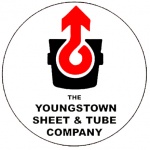This column was published in the November 2005 Issue of The Business Journal.
Making steel was dirty, demanding, dangerous.
 Not too long ago, having nothing better to do, I decided to clean out a closet filled with my stuff, you know, stuff you’re given but can’t bring yourself to display or throw away.
Not too long ago, having nothing better to do, I decided to clean out a closet filled with my stuff, you know, stuff you’re given but can’t bring yourself to display or throw away.
So it was that I came across a plaque, mounted on a large bolt, inscribed “1968 Parade of Products Festival, Canfield Fair – A relic from an early Youngstown area blast furnace- Youngstown Chamber of Commerce, Canfield Fair Board, Mahoning County Agricultural Society.”
I couldn’t remember how it came into my possession. Then the thought struck me: Maybe the people at that steel museum in downtown Youngstown would be interested in this old bolt. (Later I discovered that the correct name for the museum is The Youngstown Historical Center of Industry and Labor. Without question, the steel museum, as it is known by most, is one of the best kept secrets in the area because of the handicaps the staff labors under. The cutbacks in their budget for advertising and public relations is embarrassing.)
So, I gathered up my plaque and headed for the museum. The archivist was glad to receive the artifact. Then he suggested I have a look around. If you want to see what it was like to make steel in the old days, this is the place to find out. I drifted back in time to when I worked in the open-hearth lab at the Brier Hill Works of The Youngstown Sheet & Tube Co.
It was all there. I could almost smell it and feel it. And I was again reminded that there is no place hotter in summer (not even Hell), or colder in winter (not even the far side of Pluto) than a steel mill. Working in the open-hearth lab, where we analyzed both blast-furnace iron and open-hearth steel, separates the men from the boys. I was not directly on the charging floor all the time but went there occasionally and got to know the men who worked there. These guys were tough.
There were slaggers, second helpers, first helpers and melters. I believe there was a slagger, second helper and first helper assigned to each of the 12 furnaces. A melter would be in charge of three, maybe four, of them. While my memory may be a bit hazy on how many worked at each furnace, I remember perfectly that each man was kept so busy that he didn’t have time to stand around and talk to me about what he was doing.
My introduction to an open-hearth charging floor was mind-boggling: Fire, noise, steam, machinery everywhere. Charging machines picking up large bathtub-type containers filled with the materials that make up a heat of steel and then thrusting the tub into the open door of the furnace and flipping it over. It should be noted that a heat of open-hearth steel per furnace was over 100 tons.
As a heat began to cook, samples of the yellow, liquid steel would be taken out and rushed to the lab to see how close it was to tap time. Just like baking a cake, a heat of steel has a certain recipe that must be followed. Each heat, depending on its end use, contained prescribed elements, whether the recipe used to make hard gun steel or the soft steel that would be stamped into auto bodies and appliances.
What impressed me most were the men who worked eight hours every day, every afternoon and every midnight shift in this grinding atmosphere. It was tough on mind and body. It was certainly not a clean place so they were nearly always covered with grime. But, they made the best of it.
They always wore long underwear to absorb their sweat in summer and keep warm in winter. Not once did I hear them complain as they went about their jobs. I saw them toast their sandwiches in seconds in front of the furnace door. And I felt the excitement when it came time to tap a heat. But those are stories for another time.
After eight hours, they were ready for the showers, a change of clothes and then head for home to sleep and get up, do some chores, go out to work and do it all over again.
![]()
